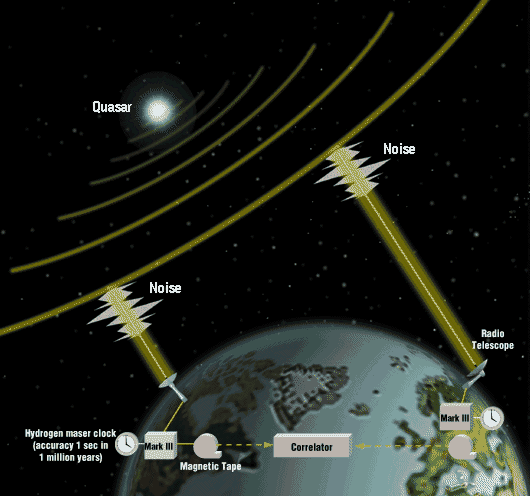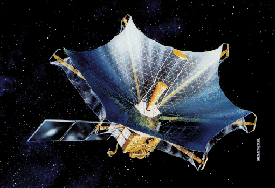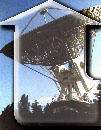Metsähovi Radio Observatory
VLBI - Very Long Baseline Interferometry
High resolution VLBI
In Very Long Baseline Interferometry (VLBI) technique several widely separated radio telescopes observe simultaneously the same target and save the observational results with exact time stamps to magnetic tapes. The data from the tapes is later combined together so that it is as if the telescopes had been a single instrument with very good resolving power. 
Each VLBI observatory must have suitable technology to handle long time broadband data recording and very accurate time referencing.
VLBI is based on international co-operation. The distance between observing telescopes may be as long as the diameter of Earth. (Or even longer using a space telescope.) Typical observational frequencies are in between 0.3 - 86 GHz (in wavelengths 90 cm - 3 mm respectively).The resolving power depends on the distance between the telescopes in observing wavelengths; the greater the distance, the greater the resolving power. The resolution gained by the VLBI technique is superior compared to any other observational method in astronomy.
VLBI in Metsähovi
VLBI observations in Metsähovi started in 1991. Today Metsähovi is one of the observing telescopes of European VLBI Network (EVN) and Coordinated Millimetre VLBI Array (CMVA). As an EVN telescope Metsähovi also participates in so-called "global-VLBI" observations which are joint observations of EVN and Very Large Baseline Array (VLBA).In the last years VLBI has taken approximately one third of annual observing time in Metsähovi. The VLBI observing frequencies of Metsähovi are 22 GHz, 43 GHz and 85 - 115 GHz.
In 2001 and 2002 "normal" VLBI measurements were slightly disturbed by the antenna system upgrade and the 147 GHz (2 mm) VLBI test experiment.
The 147 GHz experiment in March-April, 2001, was performed with Instituto de Radio Astronomia Milimetrica (IRAM) and Swedish-ESO Submillimetre Telescope (SEST). The experiment was successful and the strongest sources 3C279 and 3C273 were detected on the baseline Metsähovi-Pico Veleta (Spain). These were first detections at this high frequency in the history of VLBI.
The second 147 GHz experiment (in April, 2002) was participated by telescopes: Metsähovi, PV, SEST, Heinrich Hertz Telescope (HHT) and Kitt Peak (KP). The first results were published at the 6th EVN Symposium. Again a world record was gained; the first transatlantic detection at this high frequency.
Metsähovi has also actively been developing and maintaining VLBI instrumentation and software and has state-of-art knowledge of next-generation VLBI techniques. There are several on-going projects on that field, most of them international.
Space VLBI
By using VLBI space telescope, the resolving power at given wavelength improves as the maximal distance between telescopes increases. The HALCA satellite, part of Japanese VSOP satellite system, was launched 12th February, 1997. 

In the pictures above there is a quasar 1156+295. At left, it is imaged with ground-based VLBA data only. At right, with the addition of data from the HALCA satellite. Components in the `jet' are clearly visible. The green ellipses indicate the size of the beam of the synthesized telescope. Observations with the satellite result in a smaller beam and correspondingly better resolution.
Metsähovi participated in designing the scientific program for the VSOP project and was going to be one of the co-observing ground telescopes. Unfortunately the 22 GHz receiver of HALCA suffered from the launch. Metsähovi participated in testing the 22 GHz receiver in 1998 though. The test observations caused fringes from the bursting water maser source in Orion-KL.Metsähovi has also been involved in designing the receiving system and the scientific program of Russian space-VLBI telescope Radioastron. The launch of Radioastron was delayed year after year due to the financial problems of Russia. Finally in 2002 Russian Space Agency and Russian Science Academy chose Radioastron to be a Spektrum satellite with top priority and the launch date was set to be March 15th, 2006.
More information about future space-VLBI missions can be found for example from the U.S. Space VLBI web pages.
mm-VLBI
The same resolving power as there had been available with the 22 GHz (1.3 cm) receiver of HALCA is available by using four times shorter wavelengths with ground telescopes. This technically very challenging millimetre-VLBI technique is maturing from a technology experiment to a true scientific tool.At shorter wavelengths difficulties are accumulated: water vapour fluctuations in troposphere add phase noise to observations, receiver technology is more complex, antenna surface inaccuracies interfere more, recording bandwidth should be broader which demands more from recording equipment, etc.
The CMVA telescopes around the world are regularly making observations at 86 GHz (3 mm). Lately the number of observing telescopes in CMVA has gone up. The reason is that VLBA is installing 86 GHz receivers to its all ten VLBA stations.

In the April 1997 test experiment first correlation fringes were detected to Metsähovi at 3 mm. Since then Metsähovi has participated to the CMVA sessions.


